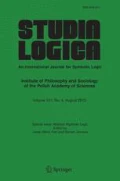Abstract
Resolution is an effective deduction procedure for classical logic. There is no similar "resolution" system for non-classical logics (though there are various automated deduction systems). The paper presents resolution systems for intuistionistic predicate logic as well as for modal and temporal logics within the framework of labelled deductive systems. Whereas in classical predicate logic resolution is applied to literals, in our system resolution is applied to L(abelled) R(epresentation) S(tructures). Proofs are discovered by a refutation procedure defined on LRSs, that imposes a hierarchy on clause sets of such structures together with an inheritance discipline. This is a form of Theory Resolution. For intuitionistic logic these structures are called I(ntuitionistic) R(epresentation) S(tructures). Their hierarchical structure allows the restriction of unification of individual variables and/or constants without using Skolem functions. This structures must therefore be preserved when we consider other (non-modal) logics. Variations between different logics are captured by fine tuning of the inheritance properties of the hierarchy. For modal and temporal logics IRS's are extended to structures that represent worlds and/or times. This enables us to consider all kinds of combined logics.
Similar content being viewed by others
References
Fitting, 1983, ‘Proof Methods for Modal and Intuitionistic Logics’, Synthese Library 169
Gabbay, D., U. Reyle, 1984, ‘N-Prolog: An Extension of Prolog with Hypothetical Implications I’ in: Journal of Logic Programming 1, 319–355
Gabbay, D., U. Reyle, 1993, ‘Computation with Run-Time-Skolemization’, in: Journal of Applied Non-Classical Logic 3, 93–134
Gabbay, D., U. Reyle, 1989, ‘Direct Deductive Computation on Discourse Representation Structures’, in Linguistics and Philosophy 17, 345–390
Gabbay, D., 1990, Labelled Deductive Systems. Principles and Applications. Vol 1: Basic Principles, Oxford University Press, in press.
Gabbay, D., 1996, ‘Fibred Semantics and the Weaving of Logics, Part 1: Modal and Intuitionistic logic’, To appear in Journal of Symbolic Logic.
Gabbay, D., 1996, ‘An Overview of Fibred Semantics and The Combination of Logics’, To appear in Proceedings of Frontiers of Combining Systems FroCoS'96, K. Schulz and F. Baader, Editors.
Kamp, H., U. Reyle, 1993, From Discourse to Logic, Vol I, Kluw
Kripke, S., 1965, ‘Semantic Analysis for Intuitionistic Logic I’, in Crossley, J. A., Dummett, M. A. E. (eds.): Formal Systems and Recursive Functions, North Holland, 92–129.
Simpson, A. K., 1994, The Proof Theory and Semantics of Intuitionistic Modal Logic, PhD Thesis, Department of Computer Science, University of Edinburgh.
Russo, A., 1996, Modal Logics as Labelled Deductive Systems, PhD Thesis, Imperial College, London, 1996
Author information
Authors and Affiliations
Rights and permissions
About this article
Cite this article
Gabbay, D., Reyle, U. Labelled Resolution for Classical and Non-classical Logics. Studia Logica 59, 179–216 (1997). https://doi.org/10.1023/A:1004952317276
Issue Date:
DOI: https://doi.org/10.1023/A:1004952317276




